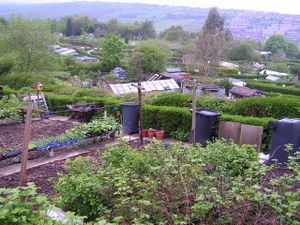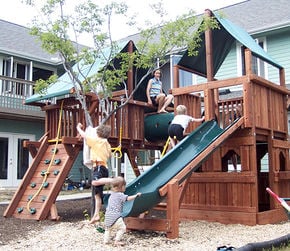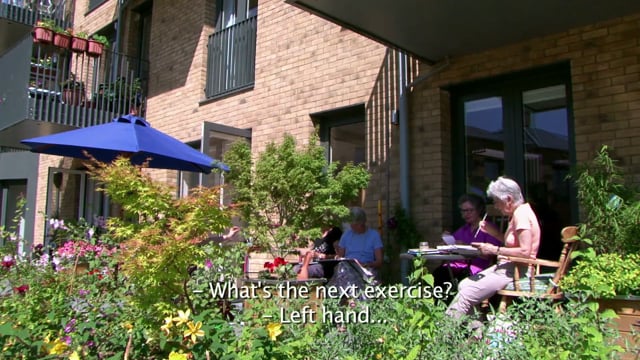This page provides a UK overview for CANs (community agency networks) and community groups with an interest in democratic ways of meeting housing need within planetary boundaries. Including for example the many communities across the whole of Southern England who feel under threat from inappropriate development, or anyone with an interest in community led housing solutions respectful of planetary boundaries.

 Announcing a Citizens' Forum on Housing!, x.com/CivicInitNI (Aug 16, 2024)
Announcing a Citizens' Forum on Housing!, x.com/CivicInitNI (Aug 16, 2024)  ‘Building something better’: the UK residents retrofitting their homes amid the climate crisis, theguardian.com (Aug 03, 2024) — From weekly skills-sharing to rewilding streets, communities are working to improve the planet while bolstering the health of people
‘Building something better’: the UK residents retrofitting their homes amid the climate crisis, theguardian.com (Aug 03, 2024) — From weekly skills-sharing to rewilding streets, communities are working to improve the planet while bolstering the health of people Demolishing buildings is bad for the planet – here’s an alternative, theconversation.com (Jul 23, 2024)
Demolishing buildings is bad for the planet – here’s an alternative, theconversation.com (Jul 23, 2024)
- England’s housing strategy carries a high carbon cost – unless politicians are willing to change plans, The Conversation (Nov 10, 2022) — "our research demonstrates that, based on current trends, England’s housing strategy could consume our entire carbon budget by 2050."
This article is the current main article for Housing and land UK community action. Separate pages cover Land activism UK, Housing UK news and Housing UK community action resources
Networks[edit | edit source]
- Community planning alliance, the grass roots group, "aim to bring together grassroots campaigns to do two things:- to lobby to improve the planning system and to support each other so that more of us can win our campaigns", added 16:22, 5 November 2021 (UTC)
- Data for Democracy, consider joining a network such as this to work on transparency of data and fair and reasonable estimates or projections of local housing need across the UK, particularly if concerned about Overdevelopment across the South, imbalance between North/South. If anyone interested... I'd love to hear from you Philralph (talk) 07:12, 5 January 2019 (PST)
- Student Co-op Homes, national member led co-operative controlled by student housing co-ops and investor supporter members, established to promote, enable and scale-up student co-operative housing in the UK. added 15:54, 17 December 2021 (UTC)
- BuildHUB, social network aimed at the self-build community, link checked 11:58, 5 August 2023 (UTC)
see also: Campaigns
What communities can do[edit | edit source]
Climate first in housing and planning!
- demand that government and politicians at all levels of government tell the truth about the carbon cost of new housing development.
- demand a more democratic system of meeting housing need
- demand a system which allows local communities to consider environmental carrying capacity and carbon costs of development, and enables them to influence the level of development to align with national and local carbon reduction targets
- support and encourage local politicians and other commentators who speak up against the undemocratic nature of the existing planning system
- form alliances to advocate for a more democratic and climate friendly planning system, for example of all areas concerned about overdevelopment, or regional alliances
- find and work with developers who explicitly concern themselves with the needs and wishes of local communities as determined and expressed by those local communities themselves, and more sustainable forms of housing
- advocate that 'objectively assessed housing need', a phrase designed to impart a false and inappropriate sense of 'authority', and to cover up what are essentially political choices, be replaced with 'democratically assessed housing need'.
- demand better data, more transparency and better exposition of relevant data, such as the size and age composition of migration flows, and better measures of genuinely affordable and sustainable housing.
see also: Community action projects
The carbon costs of new housing developments[edit | edit source]
New housing development has carbon costs from both the construction and use of the development.
It is arguable that the present system of carbon accounting does not adequately show, and make transparent, particularly to local communities affected, these carbon costs.
Given that Local plans cover several future years, this is especially of concern in the 2020's decade when as a nation, and as local communities, we should be reducing carbon costs.
The carbon costs associated with use of new housing developments has typically in recent years continued to lock us into, for the 2020's decade, yet more car dependency, when its clear we should be and should have been, promoting more sustainable means of transport.
National and local carbon costs of new housing development[edit | edit source]
A recent (Sep 2020) article[1] by Julian Stringer of Action on Climate in Teignbridge, in response to "Changes to The Current Planning System",[2] as well as extensive investigation into the likely local effects includes a paragraph on how this might play out nationally: "Building 300,000 houses a year, rather than 160,000 means that 140,000 extra houses will be built. Using 60t per house, embedded emissions from these additional houses will be 8.4Mt, UK GHG emissions in 2019 were 351.5Mt, so this is unnecessary housebuilding could add 2.4% to UK emissions each year."
Across a range of local areas eg the whole of the South of England, for some areas the percentage addition attributable to embedded emissions will of course be higher than a national average, and further additional percentages will be attributable to transport and travel implications of the new developments.
In addition to the many negative consequences that some are aware of, eg CPRE Kent supports county MPs in attack on 'inherently unreasonable' new housing targets,[3] it seems unlikely that many people are fully aware of the extent to which proposed changes would also be locking us into higher and higher, year on year carbon costs throughout the next decade when of course we should instead be reducing carbon costs.
Embodied carbon[edit | edit source]
Greenhouse gas emissions caused by the construction of new buildings and infrastructure, known as 'embodied carbon emissions', are a significant driver of climate change.
- These emissions amount to just under 50MtCO2e per year in the UK, a shocking figure that is vastly in excess of 10% of our national emissions.[4]
- Embodied carbon emissions account for up to 75% of a building's total emissions over its lifespan.[5]
- More than half the countries in the world have a smaller carbon footprint than the UK construction industry alone.[6]
Despite this, embodied carbon emissions are unregulated in the UK. Current policy and regulation focuses solely on operational energy use, as distinct from embodied carbon, and there are currently no national planning policy or Building Regulation requirements to assess, report or reduce embodied carbon emissions.
This must change. So ACAN is calling for the urgent introduction of legislation to regulate embodied carbon emissions in the UK.[7] You can help by reading ACAN's report or its summary, and by signing their petition, via architectscan.org
Disempowered communities?[edit | edit source]
Under the present (eg as at Jan 2020) planning system local authorities and communities are effectively dictated to by central government over the housing provision they are required to make via Local Plans. Not only this but those that refuse to plan for the central government numbers are threatened with even higher numbers being imposed.
Concerning the level of housing provision local communities are expected to make, any climate concerns local communities may have are not in any way catered for in the Local plan system. Central governments position that climate concerns are irrelevant looks particularly perverse, especially in the light of its own climate change legislation.
Overdevelopment in the South East and the North-South divide[edit | edit source]
Take a look at the Community planning alliance, grass roots map: google.com/maps, and zoom in a little to see how communities in the South East are disproportionately affected by overdevelopment threats.
Reducing pressure on the South East would give greater opportunity to the rest of the UK.[8]
see also: Towards a more democratic and climate friendly way of meeting housing need across England
Citizens assemblies focused on housing[edit | edit source]
In recent years citizen's assemblies have been proposed as a potential solution to dealing with divisive and highly-politicised issues such as same-sex marriage, abortion, and decarbonisation measures.
The citizens' assembly aims to reinstall trust in the political process by taking direct ownership of decision-making. To that end, citizens' assemblies intend to remedy the "divergence of interests" that arises between elected representatives and the electorate, as well as "a lack in deliberation in legislatures."
The global environmental movement Extinction Rebellion has called for citizen's assemblies on climate change to be used by governments to make decisions on climate and environmental justice. In the UK, Extinction Rebellion's 3rd demand is: 'government must create and be led by the decisions of a citizens' assembly on climate and ecological justice.' W
Citizens assemblies focused on housing would aim to tackle housing need and fair, equitable and sustainable housing provision consistent with both carbon reduction targets and environmental carrying capacity of regions.
An England citizens assembly[edit | edit source]
An England citizens assembly could, with appropriate expert advice, consider national and regional housing need, fair and proportionate carbon reduction targets for housebuilding, ways of meeting housing need more sustainably at less carbon cost, and the environmental carrying capacity of regions.
Citizens, communities and government must insist that the housebuilding sector take full responsibility for its fair and proportionate share of carbon reduction as this is the best way to ensure that the transition to zero carbon is as fair as possible to all sections of society.
Regional citizens assemblies[edit | edit source]
Regional citizens assemblies could then follow a similar process to determine fair and reasonable targets for housebuilding across their region, again informed by carbon reduction targets and environmental carrying capacity of bioregions. In subsequent iterations of the planning cycle, the experience, concerns and expertise of regional citizens assemblies would feed back into the next national citizens assembly.
Affordable housing[edit | edit source]
"... but policy makers know that if they simply allow more housing to be built the ways its always been done it will result in more carbon emissions, deepening the city's contribution to the climate crisis." Kate Raworth
Some great questions about affordable housing from just after 7 mins into this video.
Community action projects[edit | edit source]
Community land trust[edit | edit source]
Main article: Community land trust
A community land trust or (CLT) is a nonprofit corporation that holds land on behalf of a place-based community, while serving as the long-term steward for affordable housing, community gardens, civic buildings, commercial spaces and other community assets on behalf of a community.
CLTs balance the needs of individuals who want security of tenure in occupying and using land and housing, with the needs of the surrounding community, striving to secure a variety of social purposes such as maintaining the affordability of local housing, preventing the displacement of vulnerable residents, and promoting economic and racial inclusion. Across the world, there is enormous diversity among CLTs in the ways that real property is owned, used, and operated and the ways that the CLT itself is guided and governed by people living on and around a CLT’s land.
Cohousing[edit | edit source]
Cohousing is a way of sharing resources and space, and allowing for greater community and collaboration, while still giving individuals their own private space - though less private space is needed than in conventional, isolated housing.

 A model for senior living? London’s commune for older women, positive.news (Jun 14, 2023)
A model for senior living? London’s commune for older women, positive.news (Jun 14, 2023)  Cohousing is empowering people to fight back against a global housing crisis, The Conversation (Nov 02, 2022)
Cohousing is empowering people to fight back against a global housing crisis, The Conversation (Nov 02, 2022)
Housing cooperative[edit | edit source]
Main article: Housing cooperative
A housing cooperative, or housing co-op, is a legal entity, usually a cooperative or a corporation, which owns real estate, consisting of one or more residential buildings; it is one type of housing tenure. Typically housing cooperatives are owned by shareholders but in some cases they can be owned by a non-profit organization. They are a distinctive form of home ownership that have many characteristics that differ from other residential arrangements such as single family home ownership, condominiums and renting.
The cooperative is membership based, with membership granted by way of a share purchase in the cooperative. Each shareholder in the legal entity is granted the right to occupy one housing unit. A primary advantage of the housing cooperative is the pooling of the members' resources so that their buying power is leveraged; thus lowering the cost per member in all the services and products associated with home ownership.
Community-led housing in the UK[edit | edit source]
- Community Led Homes - "...community-led homes" across the UK. Your systems in your hands", The Alternative UK, Feb 13, 2019
- How to do it, communityledhomes.org.uk, added 16:27, 18 May 2021 (UTC)
- Taking action: co-production in housing and regeneration, futureoflondon.org.uk, 11 April 2019 by Charli
Community-led housing (baugruppen: Germany, projets d'habitat participatif: France, habitat groupé: Belgium. social production of habitat: Latin America) is a method of forming future residents into a 'building group' who contribute to the design and development of new housing to meet their longer term needs, rather than leaving all design decisions to a developer looking to maximise the immediate financial return.
Working together in advance of construction helps to create a sense of community as members collaborate to identify their own priorities when designing their homes and shared spaces.
Groups of this sort were developing housing in Berlin in the early 2000s as the city was rebuilt following German reunification and emerging from a long tradition of self-initiated, community-oriented living and the shared responsibility of building in Germany.
Self-help housing in the UK[edit | edit source]
- Self-help housing, helpful information from communityledhomes.org.uk, added 15:12, 6 September 2024 (UTC)
Campaigns[edit | edit source]
- see also: Networks
- saveyourgreenbelt.co.uk, added 15:04, 25 September 2023 (UTC), North Somerset and Bristol
- Farms, Fields & Fresh Air, on facebook.com, added 18:23, 5 December 2021 (UTC)
- Save Kent's Green Spaces, on facebook.com, Nonprofit organization, added 18:23, 5 December 2021 (UTC)
- Scheme for thousands of new houses near Sittingbourne would have devastating impact on countryside (and it's not even in the Local Plan), cprekent.org.uk, added 15:46, 24 September 2021 (UTC)
- Broadwater Action Group, based in East and West Malling,[9] added 12:35, 27 August 2021 (UTC)
- Save Capel, Tunbridge Wells, Kent
- STOP THE GREEN BELT GRAB! cpregravesham.org, added 18:17, 1 December 2020 (UTC)
- Protect Medway, medway.greenparty.org.uk, added 15:18, 19 October 2020 (UTC)
- Save Our South Coast Alliance an alliance of individuals and groups involved in promoting the environment, community, and economy of Chichester's coastal plain. "...excessive centrally allocated housing quotas handed down from government threaten our ability and ambition to protect our communities, environment, wildlife and economy from the inevitable impact of climate change on our low lying coastal plain." added 17:46, 24 August 2020 (UTC)
- Enough is enough - Maidstone's Housing & Infrastructure, petition against housebuilding levels in Maidstone via cprekent.org.uk, added 17:18, 18 February 2020 (UTC)
- CPRE, the countryside charity - local and regional groups, cpre.org.uk
- What gets built and where, cpre.org.uk
See also[edit | edit source]
- Land activism UK
- Housing UK news
- Housing and land UK community action resources
- Climate change solutions UK, Housing
- Climate change solutions UK, Land use
- Europe community action, Housing
- Community land trust
- Open spaces activism UK
- Saving water in South East England
- Rural sustainability UK
- Urban sustainability UK
- Neighbourhood Planning
- Urban sustainability, Urban sustainability news
- Housing, Housing affordability, Housing cooperative, Housing for flood-prone areas, Urbanization,
- Citizens data initiative UK
- Extinction Rebellion
- Citizens' assembly
- XR and future democracy
- Land use
local information can be found, or shared, via our many UK location pages
External links
Wikipedia: Drought in the United Kingdom W, 2009 Great Britain and Ireland floods W, Affordable housing W, Affordability of housing in the United Kingdom W
References
- ↑ New Government Proposals impose 1532 houses a year on Teignbridge, Summary of our concerns actionclimateteignbridge.org, Sep 22...Devon
- ↑ gov.uk, Aug 2020
- ↑ @protectkent, Sep 13, 2020
- ↑ architectscan.org
- ↑ The Carbon Footprint of Construction, The case for regulating embodied carbon emissions. ACAN Briefing note, Feb 2021 [1]
- ↑ actionnetwork.org
- ↑ architectscan.org
- ↑ londongreenbeltcouncil.org.uk
- ↑ Press release, broadwateractiongroup.co.uk










